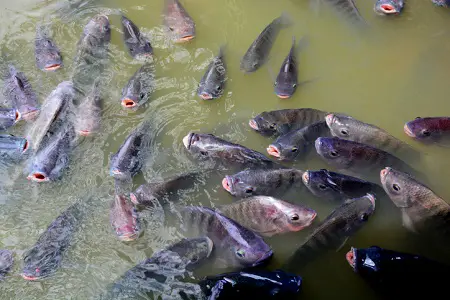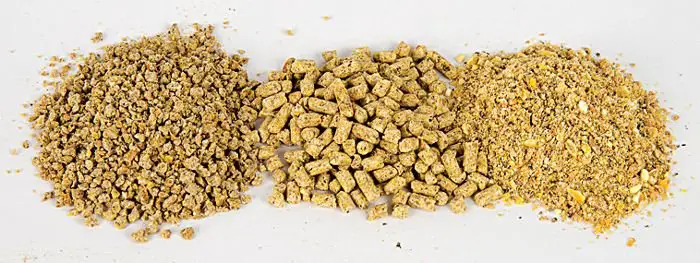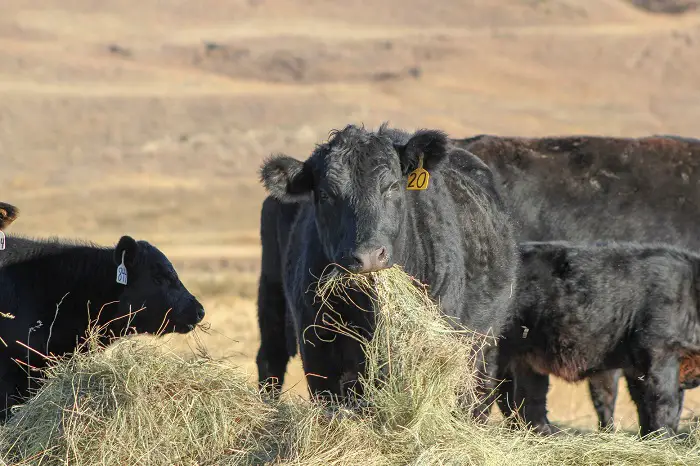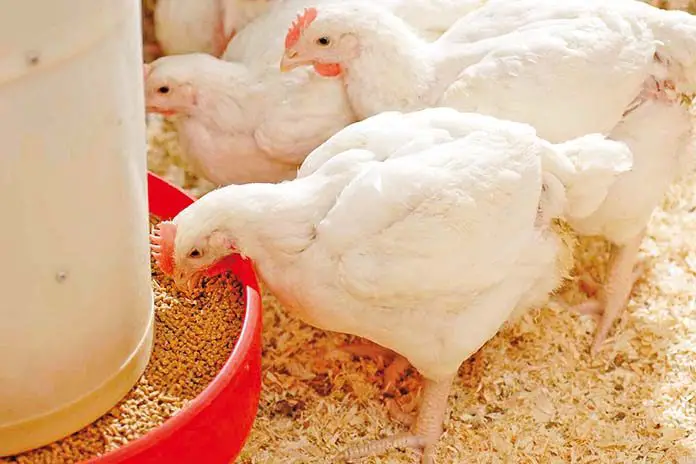Tilapia are often referred to as aquatic chickens due to their ability to feed on a diverse range of ingredients and feeds. With the commercialization of tilapia farming, most of the feed has also become commercialized as farmer aims for more profits. Tilapia feeding will depend on whether the fish are raised in cages or ponds, with those in cages reliant 100% on feed supplied by the farmer, mostly in the form of extruded floating fish pellets. These feeds are produced mainly from grains and by-products of grain processing and oil extraction like maize, wheat, soya beans, cotton seed, and sunflower, rendered animal protein is also used. Commercial tilapia feed can be very costly for the farmer affecting profitability, low cost alternative feeds utilizing locally available raw materials have, however, shown to be just as efficient. Growth under these alternative feeds might be a bit slow but this is offset by the cheaper feeding cost making the venture viable.
Contents
Pond Culture
Tilapia production in ponds is the most popular production method for fish since the fish can be fed on natural feed with minimal input. In most cases the ponds a fertilized using animal manure, the manure encourages the growth of algae and other pond vegetation and life which the tilapia can feed on. The important thing to note is that fish do not eat the manure but it encourages the growth of the organisms they feed on. Tilapia pond culture is ideal for all tilapia sizes from fry, fingerlings, and adult fish due to the diversity of marine life thriving in the fertilized pond. Different ages will feed on different feed resources in the pond, fry will feed on floating organisms. Fingerlings feed on a combination of detritus and periphyton which are a mix of algae, cyanobacteria, and other microbes submerged in the pond water. Adults will feed both on the surface and below the pond surface consuming algae, bacteria, detritus, duckweed, and other aquatic plants. Below are some examples of fertilized pond scenarios farmers can use to feed their tilapia.
Farm Animal Manure and Tilapia Fish Feeding
The aim of this setup is to provide at least 45 kilograms of animal manure per acre per day, this will give maximum tilapia yields. Different animals can be utilized to provide manure for the ponds ranging from chickens, ducks, rabbits, and pigs. To ensure a continuous supply of fresh manure to the ponds the animal production facility can be set up adjacent to the ponds or above the ponds. For chickens, both layer and broiler chickens can be used and for broilers, various cycles can be utilized in the six-month growth cycle. For broilers, this could be about 2000 chickens per acre. Ducks grown and raised intensively on ponds are allowed access to the pond where they deposit their manure fertilizing the pond. Feed wasted by the ducks can also be consumed by the tilapia and an average of four hundred and fifty ducks can be raised per acre to provide enough manure to fertilize the pond. Pigs are also a good partner animal to pair with tilapia fish pond culture because they produce a larger quantity of manure than poultry on a small piece of land. Effluent from the pig production facility can flow into the ponds solving the issue of disposing of pig manure. You will need twenty-four pigs per acre of ponds to get maximum tilapia yields.
Alternative Energy Sources
Maize is by far the most common energy or starch source for tilapia feed, the starch from the cereal also helps make the fish pellets float. Where available, cassava, broken rice and sorghum can be used as alternatives for maize in tilapia feed. Other small grains like millets can also be used to supply energy for tilapia feed, but this is still limited by supply.
Protein Alternatives
Soya bean meal and fish meal are the main protein sources in commercial tilapia feeds, these two ingredients are high in protein, and low in fat and energy. Tilapia are omnivorous so their protein requirements are a bit lower than carnivorous fish and can do well on plant sources of protein. Alternatives from oil extraction are also used as alternatives were available like sesame, sunflower, and cotton seed meal. By-products from alcohol and meat production are high in protein and hence make very good alternatives where available. Brewers waste, poultry feather meal, blood meal and meat and bone meal are viable alternatives for tilapia feed. There are plants like duckweed, cassava, and ipal ipal leaves which are also high in protein and are easy to grow, and can replace the traditional sources of protein.
Duckweed
Duckweed can be found in many waterways and in some places, it can actually overgrow and become a problem by choking out other marine life. Farmers can grow duckweed and feed to tilapia, care must be taken to feed just enough duckweed for the fish to consume all as any leftover duckweed can start growing rapidly in the pond starving the fish of oxygen or escaping into nearby freshwater bodies. Duckweed can also be fed to pigs raised in an integration involving pig manure for tilapia pond farming
Novel Ingredients
Ongoing research is coming up with a lot of novel feed ingredients the bulk of which are protein alternatives as protein is the most expensive component of tilapia feed. Black soldier fly larvae, yeast cultures, single-cell proteins, and other insects are all being evaluated and utilized with promising results. The future of protein supply is leaning very heavily towards these ingredients as the cost and environmental impact of fish, and soya meal continues to increase and come under the spotlight.
Tilapia can be fed on a diverse range of feed ingredients due to them being omnivorous in nature hence can utilize both plant and animal-based feed ingredients to derive all the nutrients they need to deposit protein. Research continues into many new feed resources for tilapia as its farming and consumption continue to grow in popularity across the globe raising it to the third most consumed fish species in the United States.




